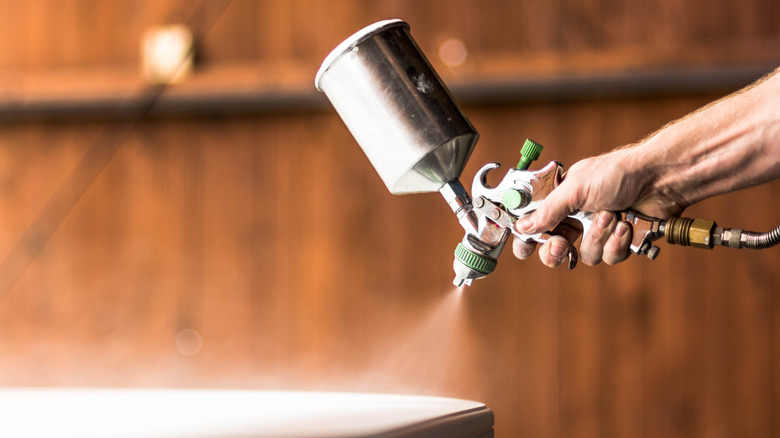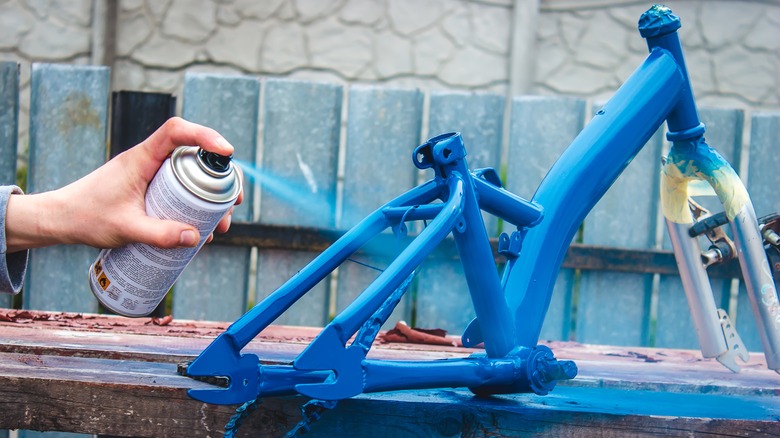The Main Difference Between A Paint Sprayer And Spray Paint
Preparing to do some painting provides you with a wide range of options for application. If spraying is your preferred method, rather than using a roller or brush, you have two options that vary widely in initial cost. A can of spray paint is inexpensive for small jobs, usually running between $5 and $10 per can. A paint sprayer, meanwhile, has a significant expense at the outset when purchasing the equipment. Handheld sprayers may cost less than $100, but large units for big jobs can cost several hundred dollars. The paint you use with the sprayer is a separate cost.
Beyond the expense, other differences exist between a paint sprayer and spray paint in a can. The large sprayer unit, which needs a power source, is ideal for huge jobs, like the side of a house, pieces of large furniture with multiple crevices and odd angles, or fences. The can is a better choice for small areas, like a single fence post or a touch-up job using a color that matches the original. For a makeover on a small piece of furniture, following a few spray painting tips can make a huge difference.
The cleanup process typically requires less time with the can, because, when the spray can is empty, just discard it. The sprayer machine has tanks, hoses, and nozzles that require cleaning before the unit goes into storage, or you'll risk clogs the next time you use it.
When it's smart to buy a paint sprayer
If you know you will be needing to repaint items multiple times over the next several years, investing in a paint sprayer machine offers a reasonable value. Perhaps you have an old shed, a wood fence, or a painted patio area. They may constantly peel and fade in direct sunlight. Having a machine on hand to use for these big jobs is handy. Some people may rent the equipment when they need it, rather than buying it. Because cleanup is such a hassle, though, it may be difficult to return a rental machine in pristine condition.
For large jobs, it's possible to purchase 5-gallon buckets of paint at a far lower price than purchasing 1-gallon cans. Many sprayer mechanisms have the ability to directly place the feeder hoses into the bucket, simplifying the job. When compared to a 5-gallon bucket, spray paint cans are inexpensive at first for small jobs. However, if you have to cover a huge area, the cost for multiple cans increases significantly, decreasing the value you receive.
Large items with extremely uneven surfaces, like a deck with old wood, would be perfect for a sprayer. The machine offers different types of nozzles that allow you to penetrate cracks and other rough spots in the wood. Because of the volume that the sprayer will generate, it makes the overall job go faster than what happens with a spray paint can.
When a paint spray can is the better choice
One of the best things about using a rattle can of spray paint is the wide range of colors and paint qualities that are available. You don't have to wait for the person behind the counter at the hardware store to try to mix the perfect color for you. Just select the color you want in the pre-mixed spray cans, and you're ready to start the job.
Rattle cans deliver the ability to work on a wide range of surface materials. When buying a 5-gallon bucket, though, you may have some limitations, like only using it on wood instead of metal or plastic.
If you haven't tried using spray paint cans in several years, you'll be surprised at the improvements now found in these products, even in the cheapest spray paint we tried from Home Depot. You'll find a better quality of paint and better nozzles than what was available in the past. Such improvements make it easier to aim the nozzle at a small space and receive desirable results. If painting a gate or piece of furniture that has a lot of open space between the support posts, for example, the nozzle on the can will deliver more precise results – resulting in less waste – than the typical nozzle on a spraying machine. It's also easier to avoid applying too much paint that leads to drips with the can than with the machine, especially when you become more skilled through practice.


